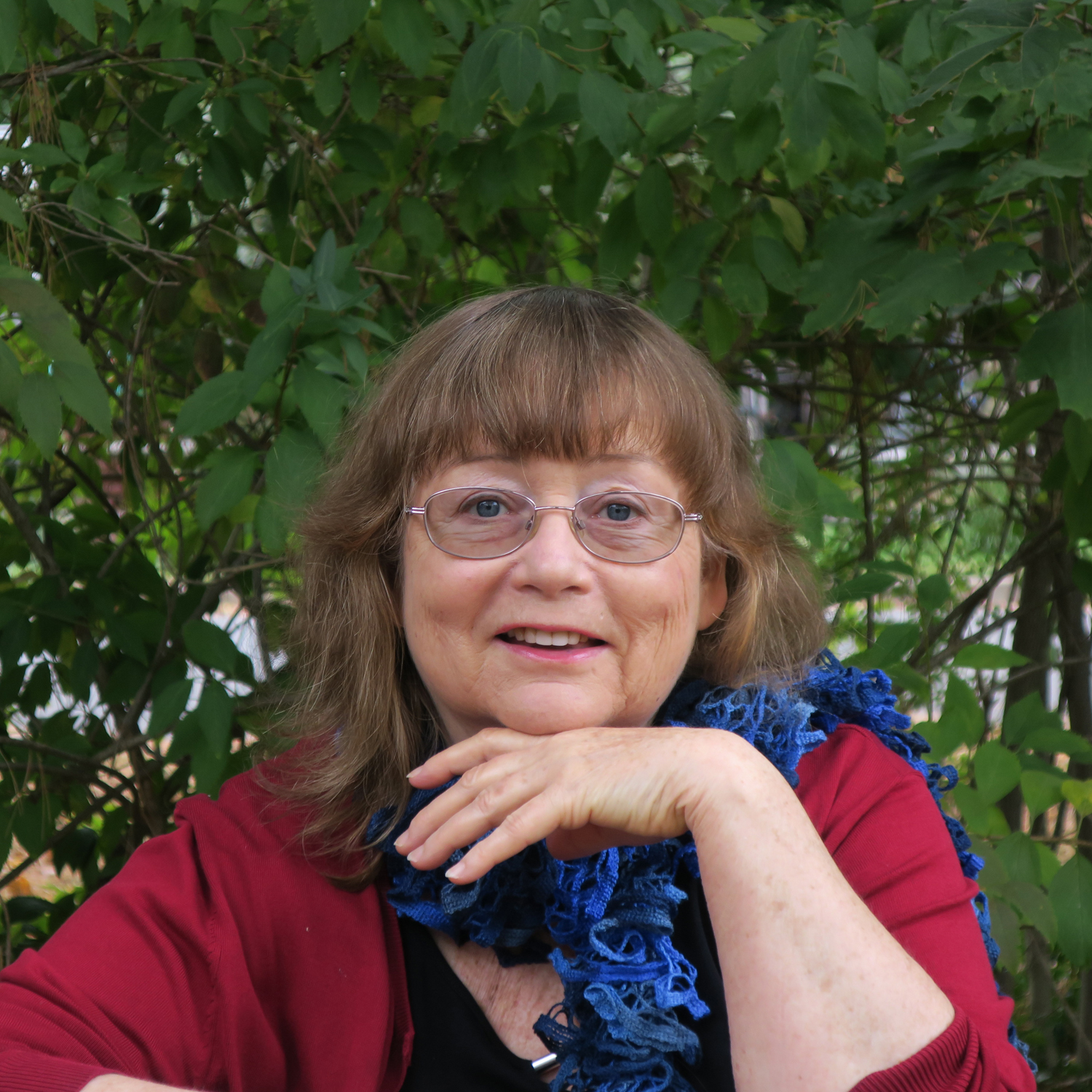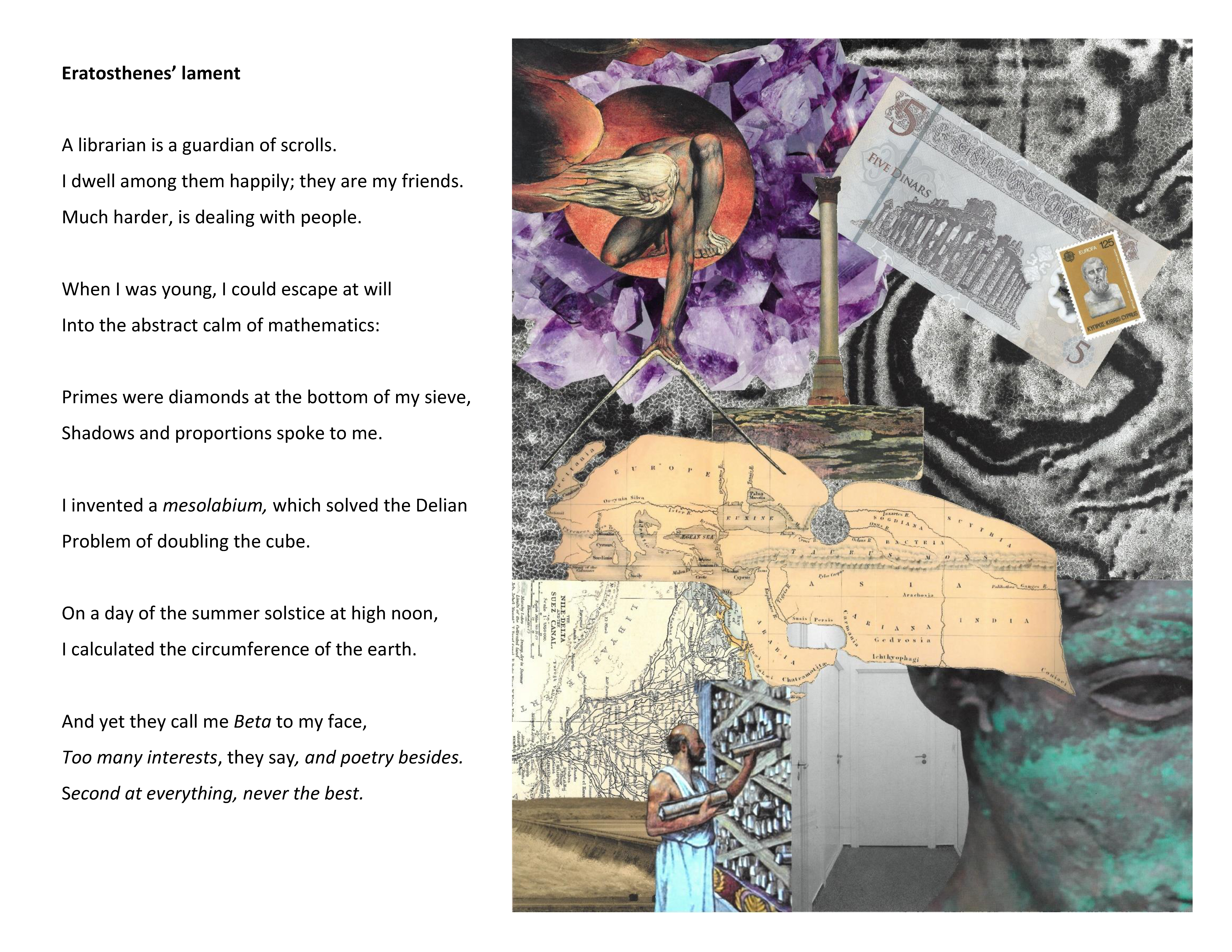A Poem-Collage Project
Poem by Sarah Glaz with Collage by Mark Sanders
The poem-collage pair appears in the Bridges 2023 online art gallery; https://gallery.bridgesmathart.org/exhibitions/2023-bridges-conference/sarah-glaz-mark-sanders
 |
 |
History, Mathematics, Poem, Collage
Eratosthenes
(276 BCE - 194 BCE) was born in Cyrene, a Greek city located in
what is present-days Libya, and was educated at Plato's Academy
in Athens. As a promising young scholar, he was invited by
Ptolemy III to Alexandria to serve as tutor for his son and heir
to the throne.
Alexandria was a Greek city situated in Egypt at the mouth of
the Nile. It was founded in 331 BCE by Alexander the Great, and
prospered after his death under the Ptolemaic rule. The
Ptolemies made Alexandria into the center of Hellenistic
intellectual life. They built the Museum (seat of the Muses), a
forerunner of the modern university, and its library, known as
The Great Library of Alexandria, which housed the largest
collections of papyrus scrolls in the ancient world. At the
height of its glory, The Great Library of Alexandria contained
about half a million papyrus scrolls, some of which were housed
in a nearby annex, the Serapeum -- the temple of the god
Serapis. The Museum was an institute of research and pursuit of
learning, attracting a large number of scholars from the
furthest reaches of the Hellenistic world. In particular,
science and mathematics flourished at the Museum like in very
few other periods of time in history. During its several hundred
years of existence, the Museum produced, in addition to Euclid
who founded the Museum's school of mathematics, other
distinguished scholars whose work determined the course of
future mathematics: Archimedes, Eratosthenes, Apollonius,
Claudius Ptolemy, Diophantus, and Hypatia were all educated or
otherwise affiliated with the Museum.
Eratosthenes
became the chief librarian of The Great Library of Alexandria in
his early thirties. He served in this position for over 40
years. Eratosthenes was a polymath, producing work in geography,
philosophy, history, astronomy, mathematics and literary
criticism. He was also a poet.
Although, admired by many of his contemporaries for the
breadth of his knowledge, his detractors nicknamed him Beta,
the second letter of the Greek alphabet, implying that although
he was knowledgeable and creative in many areas, he was first
rate in none.
Certainly not Beta in the area of mathematics, among Eratosthenes' mathematical accomplishments we count the first attempt to put geographical studies on a sound mathematical basis, including the drawing of the most accurate map available at that time of "the habitable world" appearing in the center of the collage. He also discovered a technique for finding prime numbers less than a given number, called The Sieve of Eratosthenes, which is used to these days. Mentioned in the third stanza of the poem, it appears symbolically as the purple diamonds in the top left corner of the collage. In addition, he was the first to devise a method for calculating the circumference of the earth that yielded reasonably accurate results. Eratosthenes noted how shadows fell in different geographical locations at the same time of day, and used the resulting angles and other geometric considerations to estimate the earth's circumference. This accomplishment, mentioned in the fifth stanza of the poem, is reflected in the collage's imagery through the shadow-casting pole and the compass yielding figure at top left. The pole is an image of Pompey's Pillar, the last remaining ancient monument in Alexandria, standing adjacent to the ruins of the Serapeum. The figure looming above it, is from William Blake's design "Ancient of Days," which is itself a reference to the Book of Proverbs viii. 27 "when he set a compass upon the face of the earth." Together, the images of compass and pillar evoke the permissible tools of ancient Greek geometry, the straight-edge and compass. Eratosthenes himself considered his greatest achievement to be the construction of a mesolabium, a mechanical device that calculated the "mean proportionals" necessary for the determination of the side of a cube that duplicates the volume of a given cube. The duplication of the cube, mentioned in the fourth stanza of the poem, does not appear explicitly in the collage. It is hinted at by the cube-like space between the doors in the right bottom corner. The compass and pillar mentioned above are a reminder that although this was a geometric result of some significance, Eratosthenes' duplication of the cube, was not obtained through a pure straight-edge and compass construction, but rather by the use of a more crass mechanical device. For more details, see Mark's Dissecting Eratosthenes' Lament.
According to some historical accounts, in old age
Eratosthenes lost his sight, and unwilling to live when he could
no longer read, he committed suicide by refusing to eat.
Many thanks to Claudine
Burns Smith for the technical expertise with which he
formatted the poem-collage pair to Bridges Art Exhibit
specifications.
